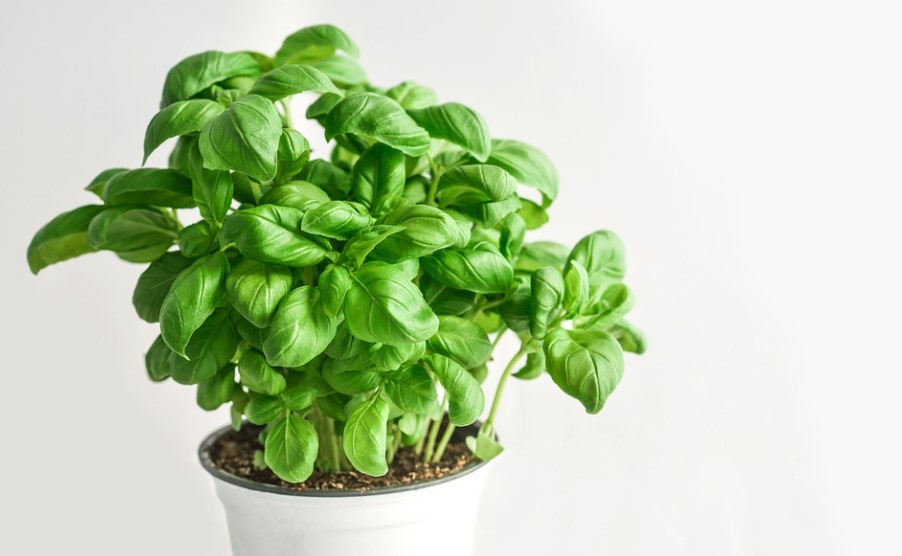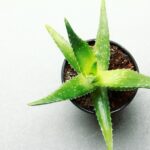Are you wishing to add a new plant to your herb collection? Then you may want to consider a basil plant. But before getting yourself one, or if perhaps you already have one, you should be aware of the care and attention your plant requires, which includes of course among other things, knowing how often to water basil.
Basil can be grown for culinary use or as ornamental. Basil leaves are used in a variety of culinary preparations. Basil is one of the easiest herbs to grow indoors, and its delicious flavor and culinary popularity make it a must-have for gardeners and cooks alike.
As you can see, keeping a basil plant in your home can bring you a number of benefits. If you are new to basil plants, you need to make sure you provide the specific care your plant requires. In the case that you haven’t been successful with your plant in the past, knowing when and how you should water them, is essential. Keep reading and learn about, how often to water basil, so you can enjoy this fantastic herb.
Basil Plant Origin
Basil plants are a popular herb native to southern Asia and the islands of the South Pacific. This member of the mint family can be grown with little fuss. Considered a tender annual, the basil herb plant produces aromatic leaves that are commonly used in Italian and Mediterranean dishes. Basil seeds are also a popular Thai ingredient.
Because basil is an annual, it grows extremely quickly. In fact, it can go from seed to harvest in as little as 3 to 4 weeks. This quick and easy-growing herb is an excellent choice for beginner gardeners.
How Often To Water Basil FAQ’s
Can basil be a houseplant?
Basil is one of the easiest herbs to grow indoors, and its delicious flavor and culinary popularity make it a must-have for gardeners and cooks alike. With the proper conditions, basil grown indoors can be just as successful as plants that are grown outdoors. Ornamental basils can be, but are not usually, harvested for eating. Another great read is knowing how often do you water aloe vera.
Are there different types of basil?
There are significant botanical differences in various types of basil plants. The many varied species of basil include sweet basil, lemon basil, Italian or curly basil, holy basil, Thai basil, and lettuce-leaf basil. The smell and flavor of basil vary upon the concentration of essential volatile oils present in the herb.
The most popular edible basil varieties such as Sweet Basil (Ocimum basilicum) contain pleasing blends of essential oils.
Can you overwater basil?
While considered an annual, you can grow basil in a container and bring it indoors for longer production. New and established plants require consistent moisture but cannot be left soggy. It is a fine line that cannot be crossed because overwatering will cause the plant stems to mildew and rot.
How do I know if my basil is overwatered?
Overwatered Basil will initially develop paler, yellowing leaves, that often start from the lower leaves upwards. Wilting of the leaves soon follows and you may notice an offensive smell from the soil. The soil will be soggy, and if you remove the plant from the pot, the roots will be mushy and brown or black in color.
How many times a week should basil be watered?
How often you need to water garden basil depends on the type of soil, the season, and the temperature. If you’ve planted your basil in rich soil that consists of a fair amount of compost, then water roughly twice per week during hot weather and once a week when it’s a bit cooler.
Should you water basil every day?
Water regularly; basil likes to stay moist and requires approximately 1 inch of water every week. Water deeply at least once a week to keep roots growing deep and the soil moist. Basil growing in containers will need more frequent watering.
Can basil get too much sun?
Full-sun conditions may lead to leaf scorch on seedlings, which causes discoloration and a droopy effect, especially along the edges of the leaves. Anything less than full sun for mature basil plants has the same effect, sans discoloration.
Why are my basil leaves falling off?
Basil plant droop that appears suddenly on young plants is often caused by fusarium wilt, a fungal disease that causes stunted growth and droopy, wilted, or yellow leaves. Eventually, leaves may drop from the plant. Fusarium wilt is difficult to manage and can remain in the soil for 8 to 12 years.
Is it better to plant basil indoors or outdoors?
Basil is a hardy herb that grows extremely well both indoors and outdoors. As long as the plant receives the proper moisture and sunlight, it will thrive in any location.
How to plant basil?
- Choose a location with plenty of sunlight. Basil thrives in warm temperatures and full morning sun.
- Amend the garden soil with plenty of organic matter to create a rich, well-draining foundation for your basil. The bed or garden container should be at least 8 inches deep for strong root growth.
- Space your basil plants 12 to 16 inches apart to allow plenty of sunlight and airflow.
- Dig a hole and place the basil seedling so that the root ball is level with the soil. Use a transplanter to fill in any gaps. Then, use your hands to press the soil firmly around your transplanted basil.
- Water your basil and apply 1 to 2 inches of mulch to help conserve moisture and prevent competition from weeds.
How to care for a basil plant?
- Water regularly: Basil likes to stay moist and requires approximately 1 inch of water every week. Water deeply at least once a week to keep roots growing deep and the soil moist. Basil growing in containers will need more frequent watering.
- Fertilize lightly: If you choose to add fertilizer, a light application of a liquid fertilizer twice a season is all you really need for basil growing outdoors. If you’re planning to grow basil in a pot and want to add fertilizer, your plants will require only a very weak liquid solution every 3 to 4 weeks to compensate for nutrients washed away by frequent watering.
- Pinch back leaves: Pinch leaves from the tips of your basil as soon as the plant has two sets of true leaves. This encourages your basil to grow full and bushy.
- Companion planting: Using this technique gives basil an excellent advantage.
- Avoid bolting: Also known as “going to seed,” you can avoid bolting by keeping a close eye on your plant. Basil tends to bolt once summer days are consistently hot.
How Often To Water Basil
Basil plant watering indoors
- Correct watering for your herbs depends on the type of soil, the temperature, and where it has been planted.
- Pots and containers are a good way to start growing basil. First, make sure that the pots you’re using have drainage holes so any excess water can run through and you avoid overwatering your plant.
- During the warmer months, it’s recommended to water basil every three days to avoid the soil drying out too much. However, if your pot is in a slightly shadier spot, you may find watering every four days adequate.
Most store-bought basil plants come in black plastic pots. It’s best to transfer your basil to a ceramic, clay, or terracotta pot immediately to avoid the soil drying out too quickly. - Check how moist the soil is by touching it with your fingers. If it still feels very moist, there’s no need to water. If the soil feels somewhat dry, you can add some water.
- Once your basil has grown to more than 10 inches and things are beginning to look a little crowded, repot your plant to a larger pot. Because a larger pot can store more water.
- If you’ve recently planted basil, you should water the seedlings every two days, or even daily, if the temperatures are very hot and you find that the soil dries out too quickly.
How Often To Water Basil outdoors
- If you’ve planted your basil in rich soil that consists of a fair amount of compost, then water roughly twice per week during hot weather and once a week when it’s a bit cooler. That’s because rich soil contains more moisture.
- If there’s a lot of rainfall, you may not need to water at all.
- You could add compost after you’ve planted your basil to ensure that the soil stays a little moister. Soil types such as clay may require more frequent watering.
- If you’re watering basil seeds in the garden, it’s important that you don’t overwater them because that could lead to flooding. As a result, your basil plants may never even begin to sprout at all.
Watering basil seedlings
- It is important to maintain a good balance of moisture whilst basil seedlings are developing roots.
- As with all basil plants, the aim is to maintain moist soil without it becoming boggy as this can lead to fungal disease and root rot.
- With seedlings, careful monitoring of the soil moisture and watering accordingly is more important than general watering instructions as there are a lot of variables that can either dry out the soil or maintain its moisture.
Gaea’s Blessing Seeds
Classic pesto basil has been in cultivation for countless generations and has a highly concentrated flavor and a fine, sweet fragrance.
The perfect addition to any herb garden and sure to be a perennial favorite, we also love Spiderwort Plants which are also perennials, you. can learn How to Care for a Spiderwort Plant and all about them here..
This heirloom variety has a uniform, medium-large leaves, these plants are slow to go to seed and slow to bolt, which means a longer harvest and heavy yields – this makes it perfect for drying, all-around great eating, and large-scale pesto production.
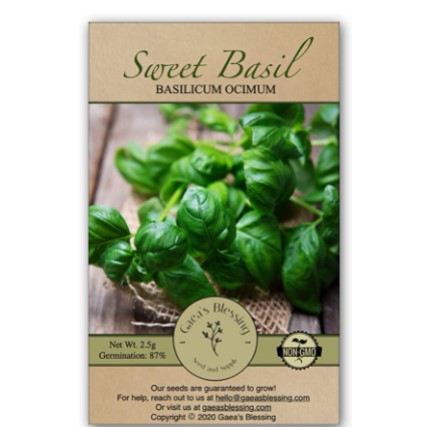
Features:
- Summer to Fall
- Full Sun
- Non-GMO
Heirloom Non-GMO Herb Seeds
Enjoy a variety of herbs. Your seed kit includes the following gardening favorites; arugula, basil, chives, cilantro, dill, garlic chives, lavender, lemon balm, mint, oregano, parsley, peppermint, rosemary, sage, and thyme.
Mark your herb planters with included labels so you know what will sprout next. Learn everything you need to know to grow and use a bountiful harvest with your digital grow guide.
Keep your spare garden seeds safe and dry for next year’s planting in a resealable, waterproof mylar bag with individually packed seed packets.
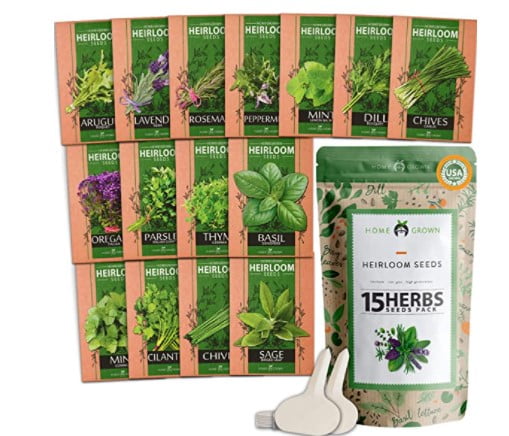
Features:
- GMO-Free
- Heirloom
- Outdoor
Genovese Sweet Basil Seed for Planting
A large color packet of the popular culinary herb Genovese Basil (Ocimum basilicum), a wonderful gift for the gourmet cook and gardener. Minimum of 500 mg per packet.
A carefully selected variety that can easily be grown indoors in your kitchen or outdoors in the garden. There is actually enough seed to do both.
Imagine fresh basil for your bruschetta, pesto sauce, or homemade pizza. Growing your own herb garden is a great way to make your food look, smell, and taste gourmet.
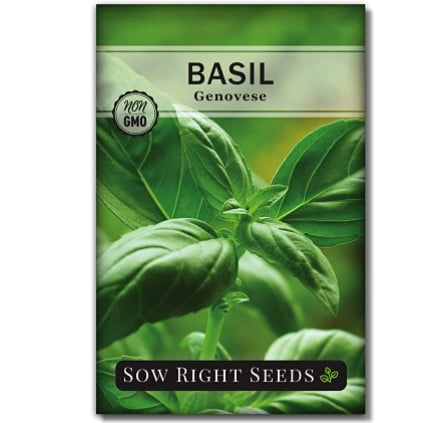
Features:
- Indoor or Outdoor
- Heirloom
- Non-GMO

